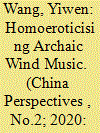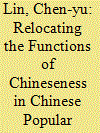| Srl | Item |
| 1 |
ID:
173000


|
|
|
|
|
| Summary/Abstract |
This article explores Archaic Wind music (gufeng 古風) and its implications for Sinophone articulations. Gufeng can be categorised as a particular type of music with lyrical, musical, and symbolic references to ancient China that is produced, consumed, and circulated within an online fan community. While the lyrics of gufeng music express a post-loyalist yearning to return to the fictional roots of “Cultural China,” its video adaptations deconstruct the authenticity of such cultural roots in their homoerotic subtext. Exploring the audio-visual texts of the gufeng music, I suggest that it shows a rhizomatic return to ancient China that disorients the routes to the past.
|
|
|
|
|
|
|
|
|
|
|
|
|
|
|
|
| 2 |
ID:
172999


|
|
|
|
|
| Summary/Abstract |
While the popularity of China Wind (zhongguofeng 中國風) music during the 2000s has waned somewhat since its peak, the notion of Chineseness in popular music requires reconfiguration. In the world of popular music, transnational flows of culture, migration, and capital have created various forms of Chineseness with different functions. This article examines two ways in which the perception of Chineseness functions in the music industry, namely as a re-centred Chineseness in the creative industries, and Chineseness as a globalising project, by examining the internationally franchised televised music contest The Voice of China and the recent work of two artists known for their China Wind songs, Jay Chou and Wang Leehom. Through textual analysis of media content and songs, as well interviews with industry practitioners, this article argues that Chineseness in today’s Chinese popular music is often shaped by markets, industrial practices, media censorship, state policy, and cross-industry convergence, and musicians’ artistry increasingly plays a part in forming and authorising the representation of Chineseness in contemporary Chinese popular music.
|
|
|
|
|
|
|
|
|
|
|
|
|
|
|
|